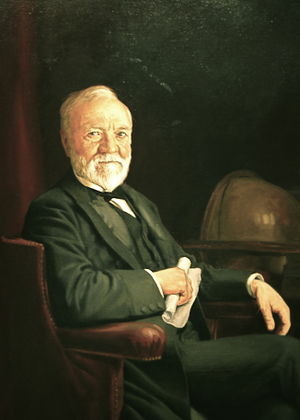Difference between revisions of "Andrew Carnegie"
(cnn money quote) |
|||
| (One intermediate revision by one other user not shown) | |||
| Line 1: | Line 1: | ||
{{person | {{person | ||
|wikipedia=https://en.wikipedia.org/wiki/Andrew_Carnegie | |wikipedia=https://en.wikipedia.org/wiki/Andrew_Carnegie | ||
| + | |wikiquote=https://en.wikiquote.org/wiki/Andrew_Carnegie#Wealth,_1889 | ||
|spartacus=http://spartacus-educational.com/USAcarnegie.htm | |spartacus=http://spartacus-educational.com/USAcarnegie.htm | ||
| − | |image= | + | |alchetron=https://alchetron.com/Andrew-Carnegie |
| + | |infogalactic=https://infogalactic.com/info/Andrew_Carnegie | ||
| + | |image=Andrew Carnegie in National Portrait Gallery IMG 4441.JPG | ||
|birth_date=1835-11-25 | |birth_date=1835-11-25 | ||
|death_date=1919-08-11 | |death_date=1919-08-11 | ||
| Line 17: | Line 20: | ||
}} | }} | ||
==Career== | ==Career== | ||
| − | Andrew Carnegie was a steel magnate. He | + | Andrew Carnegie was a steel magnate. He founded the [[Carnegie Steel Company]] and the [[Carnegie Corporation of New York]] |
He also founded the [[Carnegie Endowment for International Peace]], [[Carnegie Institution for Science]], [[Carnegie Mellon University]], [[Carnegie Trust for the Universities of Scotland]] and the [[Carnegie Hero Fund]]. | He also founded the [[Carnegie Endowment for International Peace]], [[Carnegie Institution for Science]], [[Carnegie Mellon University]], [[Carnegie Trust for the Universities of Scotland]] and the [[Carnegie Hero Fund]]. | ||
| + | {{SMWQ | ||
| + | |text=[[Andrew Carnegie]] was regarded in his day not just as a [[robber baron]] but--after the [[Homestead Strike]] of [[1892]], in which hired guards killed seven [[striking]] steelworkers--as a plutocrat with blood on his hands. He reshaped his image by giving away most of his fortune during his lifetime, and today he is remembered less for the strike than for his phrase 'the man who dies...rich dies disgraced.' | ||
| + | |subjects=Philanthrope | ||
| + | |authors= Andy Serwer, Jeanne Lee | ||
| + | |source_details=http://web.archive.org/web/20060624085630/http://money.cnn.com/magazines/fortune/fortune_archive/1999/03/15/256491/index.htm | ||
| + | }} | ||
==Actvities== | ==Actvities== | ||
Together with [[John D. Rockefeller]], Carnegie was a major backer of [[schools]] in USA.<ref>The Underground History of American Education</ref> | Together with [[John D. Rockefeller]], Carnegie was a major backer of [[schools]] in USA.<ref>The Underground History of American Education</ref> | ||
| + | |||
{{SMWDocs}} | {{SMWDocs}} | ||
==References== | ==References== | ||
{{reflist}} | {{reflist}} | ||
{{Stub}} | {{Stub}} | ||
Latest revision as of 18:02, 5 May 2021
(businessman) | |
|---|---|
 | |
| Born | 1835-11-25 Dunfermline, Fife, Scotland, UK |
| Died | 1919-08-11 (Age 83) Lenox, Massachusetts, United States |
| Religion | Northern Presbyterian |
| Parents | William Carnegie Margaret Morrison Carnegie |
| Children | Margaret Carnegie Miller |
| Spouse | Louise Whitfield |
| Founder of | Carnegie Corporation, Carnegie Endowment for International Peace, Carnegie Mellon University |
| Party | Republican |
Career
Andrew Carnegie was a steel magnate. He founded the Carnegie Steel Company and the Carnegie Corporation of New York
He also founded the Carnegie Endowment for International Peace, Carnegie Institution for Science, Carnegie Mellon University, Carnegie Trust for the Universities of Scotland and the Carnegie Hero Fund.
“Andrew Carnegie was regarded in his day not just as a robber baron but--after the Homestead Strike of 1892, in which hired guards killed seven striking steelworkers--as a plutocrat with blood on his hands. He reshaped his image by giving away most of his fortune during his lifetime, and today he is remembered less for the strike than for his phrase 'the man who dies...rich dies disgraced.'”
Andy Serwer, Jeanne Lee [1]
Actvities
Together with John D. Rockefeller, Carnegie was a major backer of schools in USA.[2]
References
- ↑ http://web.archive.org/web/20060624085630/http://money.cnn.com/magazines/fortune/fortune_archive/1999/03/15/256491/index.htm
- ↑ The Underground History of American Education